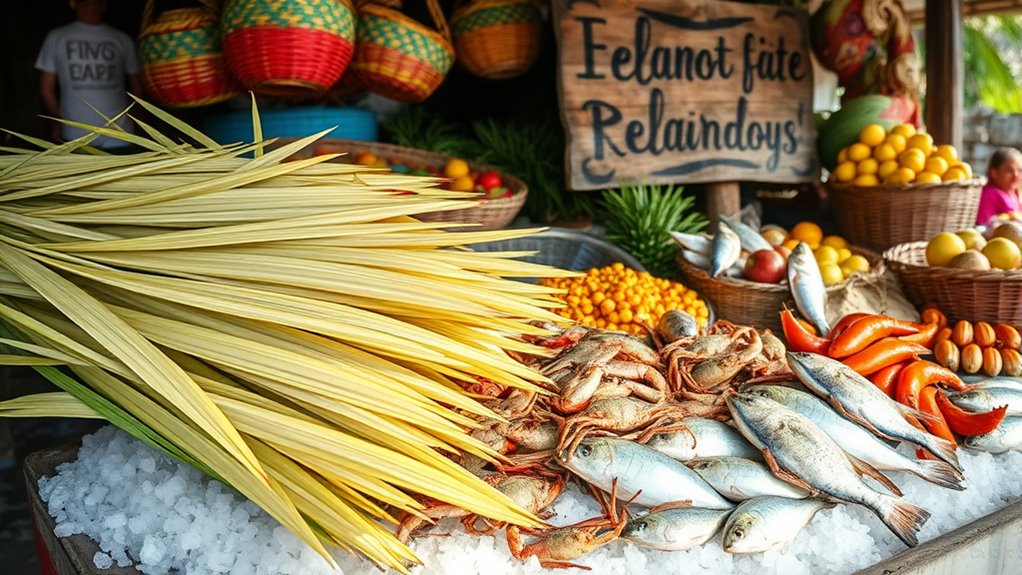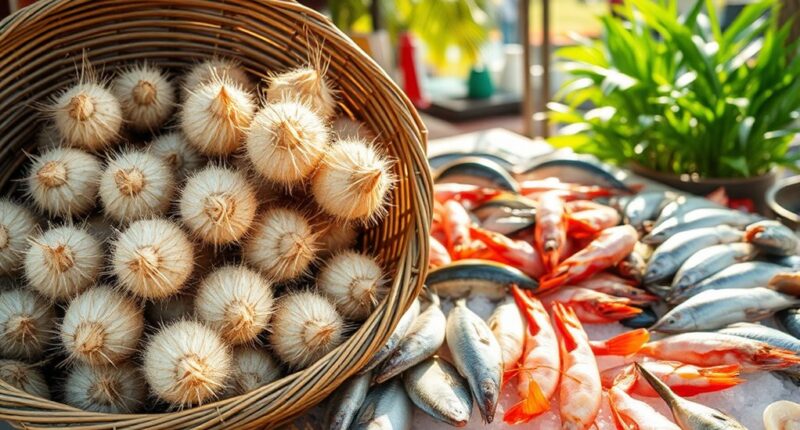Islander cuisine artistically combines traditional cooking techniques with fresh, diverse ingredients from land and sea. You’ll find seafood like fish, crab, and mollusks prepared using methods such as grilling, steaming, and fermenting, often infused with coconut, herbs, and tropical fruits. These dishes reflect cultural influences and resourcefulness, creating bold flavors that celebrate the region’s natural bounty. To discover how these flavors and techniques come together, explore the unique culinary traditions that define island life.
Key Takeaways
- Islander cuisine showcases a rich mix of seafood, tropical fruits, root vegetables, and coconut-based ingredients.
- Traditional methods like grilling, steaming, and fermenting preserve natural flavors and highlight local resources.
- Flavors are vibrant and diverse, combining spicy, sweet, and aromatic notes from herbs, spices, and fresh produce.
- Cultural influences from trade and migration shape the cuisine’s unique blend of land and sea ingredients.
- The culinary identity emphasizes authenticity, resourcefulness, and a dynamic balance between tradition and innovation.

Have you ever wondered what makes island cuisine so vibrant and unique? It’s a combination of rich traditional cooking methods and incredible ingredient diversity that creates a flavor profile unlike anywhere else. When you explore into island food, you quickly realize how history, geography, and local resources shape every dish. Traditional cooking techniques, passed down through generations, form the backbone of island culinary culture. These methods often include grilling over open flames, steaming, fermenting, and using coconut milk or oil to add depth and richness. Such techniques help preserve ingredients and bring out their natural flavors, making each dish a celebration of local resources. The use of natural materials and authentic methods further enhances the traditional appeal of island dishes.
Island cuisine blends traditional methods and diverse ingredients, celebrating local resources and rich flavors.
The ingredient diversity on islands plays an essential role in defining the cuisine. Because islands are surrounded by water, seafood is a staple in almost every meal, from freshly caught fish to shellfish like crabs, lobsters, and mollusks. You’ll find that seafood isn’t just a main course but also a key component in soups, stews, and even snacks. Beyond seafood, islanders make extensive use of tropical fruits like mangoes, pineapples, and papayas, which add sweetness and brightness to dishes. Root vegetables such as taro, cassava, and yams are also central, often used in traditional cooking to create hearty stews or side dishes.
Herbs and spices native to the islands contribute to the unique flavors. Think of fragrant lemongrass, fiery chili peppers, and aromatic ginger, all used generously to enhance dishes. Coconut, whether grated, milked, or toasted, plays a fundamental role, adding richness and a hint of sweetness. The diversity of ingredients means that island cuisine is both vibrant and adaptable, blending flavors from different continents and cultures that have touched the islands through trade and migration.
When you explore island cuisine, you’ll notice how it reflects a harmony between land and sea, tradition and innovation. Local cooks often combine ingredients in ways that maximize flavor and nutrition, creating dishes that are both satisfying and reflective of the island’s history. Whether it’s a simple grilled fish seasoned with herbs or a complex stew simmered with a variety of roots and vegetables, each dish tells a story of resourcefulness and cultural richness. The use of fresh, local ingredients and traditional cooking techniques makes island cuisine both authentic and distinctive. The result is a cuisine that’s as colorful and dynamic as the islands themselves, rooted in traditional cooking but constantly evolving through ingredient diversity.
Frequently Asked Questions
How Do Traditional Island Recipes Vary Across Different Islands?
You’ll find that traditional island recipes vary widely by location, reflecting local ingredients and cultural influences. Different islands use unique local spice blends to add flavor, and cooking techniques differ based on available resources. For example, some islands favor grilling, while others rely on steaming or boiling. These variations create diverse dishes, giving each island its distinct culinary identity rooted in local traditions and natural resources.
What Are the Health Benefits of Island Seafood Dishes?
You’ll find that island seafood dishes offer impressive nutritional benefits, especially as rich omega-3 sources. These healthy fats support your heart, improve brain function, and reduce inflammation. By including fresh fish and seafood in your diet, you get essential nutrients that boost overall health. So, enjoying island seafood isn’t just delicious—it’s a smart choice for your well-being, providing crucial omega-3s and other nutrients naturally.
How Has Colonial Influence Shaped Island Cuisine Today?
You might be surprised how colonial legacy has shaped your island cuisine today. Colonial influence brought new ingredients, cooking techniques, and flavors, blending them into traditional dishes. This culinary fusion creates vibrant, diverse flavors that reflect your island’s history. While some recipes retain their roots, others incorporate colonial elements, illustrating how history and culture intertwine to give you a unique and rich culinary landscape that’s both familiar and new.
What Are Popular Island Ingredients Not Commonly Used Elsewhere?
You’ll notice that island cuisine features ingredients like tropical fruits, which add vibrant flavors to dishes, and rare spices that aren’t common elsewhere. These ingredients reflect the islands’ unique climate and culture, setting their cuisine apart. You might find starfruit, breadfruit, or plantains alongside locally sourced seafood. Using these distinctive ingredients, islanders create fresh, flavorful meals that showcase their rich, tropical heritage.
How Do Island Cooking Methods Differ From Continental Techniques?
Ever wonder how island cooking methods stand out? You’ll notice that islanders often favor grilling techniques that enhance their fresh seafood and meats, creating smoky flavors unique to coastal living. They also embrace fermentation methods, preserving ingredients and developing bold tastes that reflect their resourcefulness. Unlike continental styles, island cooking emphasizes simplicity, outdoor grilling, and fermentation, making every meal a celebration of their environment and culture.
Conclusion
Think of island cuisine as a vibrant tapestry, woven from the threads of sago, seafood, and tropical flavors. Each dish is a splash of color, telling a story of tradition, resourcefulness, and connection to the sea. By exploring these flavors, you’re diving into an ocean of culture and history. Embrace the journey, and let the tastes carry you across a vast, delicious island landscape—where every bite is a wave of heritage.
Mary is a passionate writer who brings creativity and a fresh perspective to our team. Her words have the power to captivate and inspire, making her an essential contributor to our content. Mary’s commitment to storytelling and dedication to promoting Indigenous culture ensures that her work touches the hearts of our readers. We’re fortunate to have her as part of our team.










